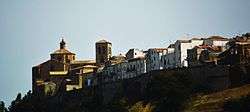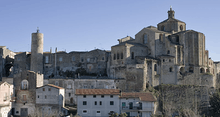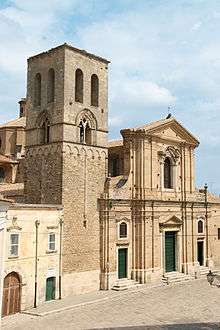Irsina

| Irsina | ||
|---|---|---|
| Comune | ||
| Comune di Irsina | ||
 | ||
| ||
 Irsina Location of Irsina in Italy | ||
| Coordinates: 40°45′N 16°14′E / 40.750°N 16.233°E | ||
| Country | Italy | |
| Region | Basilicata | |
| Province / Metropolitan city | Matera (MT) | |
| Frazioni | Borgo Taccone | |
| Government | ||
| • Mayor | Nicola Massimo Morea | |
| Area | ||
| • Total | 263.47 km2 (101.73 sq mi) | |
| Elevation | 548 m (1,798 ft) | |
| Population (31 May 205)[1] | ||
| • Total | 4,965 | |
| • Density | 19/km2 (49/sq mi) | |
| Demonym(s) | Irsinesi | |
| Time zone | CET (UTC+1) | |
| • Summer (DST) | CEST (UTC+2) | |
| Postal code | 75022 | |
| Dialing code | 0835 | |
| Patron saint | Saint Euphemia | |
| Saint day | 16 September | |
| Website | Official website | |
Irsina is a town, comune (municipality) and former Latin bishopric in the province of Matera, in the Southern Italian region of Basilicata.
The economy is mostly based on agriculture, with the production of cereals and wine.
The town

The medieval part of Irsina is a labyrinth of cobblestone roads winding and opening up into little squares with scenic views over the vast countryside. It is an agricultural town. Churches and fountains are familiar landmarks. The town boasts an important 13th-century cathedral which was partly rebuilt at the end of the 18th century. The remains of a Norman castle have since been incorporated into the crypt of the former monastery of San Francesco.
Around the more modern part of the village, cafés and shops painted in warm hues of beige, rose-petal and yellow snugly sit beside each other. The whole village is perched on a hill overlooking Italy’s grain plateau – in fact, the area produces a lot of the grain used to make pasta in the whole of Italy.
Village and nearby countryside
Irsina sits on the border between the regions of Apulia and Basilicata, with the Council of Materia. The population is about 5000 people, living in about 2000 households. The geography of the town is very simple. There is a medieval part with narrow cobbled streets and small squares. The new town is joined to the old by a main street which has now become the commercial focus, with small bars, a few restaurants, small shops, surrounded by much housing.
21st century


Once known as Montepeloso, Irsina sits on the top of a hill at around 550 metres (1,800 ft) above sea level and enjoys panoramic views of the surrounding countryside. Ancient walls embrace the historical centre, the watch towers, the elegant buildings, the small churches, the narrow alleyways and the old gates to the town.
Irsina has been an area of settlement for many thousands of years. It became a fortified town in medieval times and has belonged to some of the most powerful families in Italy. Irsina's strategic position saw the struggle for dominance alternate between the Normans, Swabians, Angevins and Aragòns and consequently, was often destroyed and rebuilt in the process.

Irsina today is a pretty, magical and unspoilt village with a small community of English speaking residents, mostly from Britain, Ireland and Belgium who live there either full-time or enjoy holiday homes there. There is also a growing artist group encouraged by the art and Italian classes offered every summer in the Old Town. Irsina is just coming onto the tourist radar.
The village is one hour from Bari Airport (Ryanair), and hour and a half from Brindisi airport, (also Ryanair). It is one hour from the beach, and thirty minutes from Matera. The countryside is interspersed with rivers, lakes, fields, woods and archaeological ruins.
Festivals
Festival of Piety, Pizzicanto (Last weekend in May)
The old festival of Piety is celebrated in the centre of Irsina on the last Sunday of May. In the past, the procession started from the small church of the Madonna della Pietà, near the allotments just outside the town, and ended at the Cathedral. The game 'pizzicanto' is still played where two teams of young locals form a human pyramid and move along the streets in circular movements, enlivening the followers with a traditional song sung in local dialect. Those on top sing: 'You underneath, be careful not to drop us. If you make us fall we'll give you a good beating'. Those below respond: 'You on top, hold yourselves up properly. If you fall, we'll give you a good beating'. The game repeats itself when the team loses balance and the pyramid collapses. In the past, the trade of the participants, farmers, bricklayers etc. divided teams. This tradition also exists in parts of Spain.
Festival of Saint Roch, (15 – 17 August)
The festival of Saint Roch (Sand’Rocc) is unique to Irsina. Every year on 15 August (a national holiday known as 'Ferragosto'), women in the old town of Irsina prepare small altars in their basements, garages and cellars, in honour of the Saint from Montpellier, to be visited from the evening of the 15th until dawn of 17 August.
For two nights locals stay awake, singing nursery rhymes, in dialect, that recount of the life and miracles of Saint Roch. To the sound of the accordion, traditional dances such as the 'tarantella', 'mazurka' and 'quadriglia' are alternated, with the occasional modern dance. Spectators can admire the spotless sheets and finely embroidered tablecloths that would have been completed by the old women in their youth, and are used just for this occasion. On the altar, images and small statues of the Saint are positioned, whilst the rooms are decorated with plants, typical handicrafts and perfumed with basil herbs.
During the vigil for Saint Roch on the night of 15 August, in between the dancing and singing, 'i pettl', or savoury doughnuts are fried in the garages and cellars alongside the revellers. There is also a prize for the best decorated altar, a lamb.
Festival of Saint Eufemia, (14 – 17 September)

The festival of Saint Eufemia is the oldest and most poignant tradition of Irsina. It is an annual event from 14–17 September with the most important day being the 16th, when a procession of representatives from the civil and military authorities, together with the Festival Committee, enter the Cathedral and deliver the keys of the town to the Bishop. The subsequent handing over of these keys from the Bishop to the custodian of Irsina, Saint Eufemia, is always a moving moment for the crowds.
A long street procession then takes place where faithful followers of Saint Eufemia carry an image of the Saint, the relic of her arm and the icon of Saint Mary of the Divine Providence (Maria S.S. Madre della Divina Provvidenza) to the streets of Irsina. The celebrations continue with fireworks displays, brass band concerts and marches, street lighting and on the last day, a pop concert.
Main sights



- Irsina Cathedral (Cattedrale di Santa Maria Assunta) was built in the 13th century and rebuilt in 1777. It has a Baroque façade and a Gothic bell tower with mullioned windows. The interior houses a red marble baptismal font, and a marble statue of Saint Euphemia, the town's patron saint (claimed as the only known sculpture by Andrea Mantegna) and several canvasses of the 18th century Neapolitan school.
- Church of the friary of St. Francis (former castle of Frederick II). Dating to the 12th century, it was rebuilt in the 16th century. The crypt has 14th-century frescoes of the Umbrian-Sienese school portraying the Redeemer, the Incoronation, the Annunciation, the Crucifixion and the Resurrection.
- Church of Maria S.S. del Carmine, housing a 17th-century painting of the Marriage at Cana.
- Church of the Madonna della Pieta (1703). It is located opposite the western side of the walls of the ancient Montepeloso, in an affected area since the eleventh century by the Benedictine monastery of St. Mary of Juso .
Notable locals
Irsina is the hometown of composer Giovanni Maria Trabaci and, probably, of Chicago Outfit boss Johnny Torrio.
Twin towns
-
 Sassuolo, Italy
Sassuolo, Italy -
 Sant'Angelo del Pesco, Italy
Sant'Angelo del Pesco, Italy
